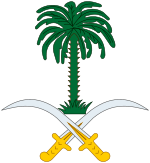Palm (heraldry)


The Palm has, like the palm fronds , in the heraldry as a coat of arms figure managed.
The representation takes place in the coat of arms and also as a gem next to or behind the shield as a whole plant. The plant can be found in the coat of arms as a helmet jewel . The palm is predominantly in green tinged , rare in gold or other colors, and as stylized other plants more or less. The species chosen is mainly limited to the date and coconut palm . The number often chosen is one or two pieces. The palm, also the palm frond, is understood as the symbol of peace. The entry into heraldry can be dated to the Middle Ages , for example in the coat of arms of the von Pfuel family , an old noble family from the Barnim in Brandenburg .
In the coat of arms of the Dominican Republic , the palm tree has become the so-called freedom tree of the insurgent slaves since 1802 under the term palmetto . In the flag and in the coat of arms of Haiti it has achieved the same fame with the Jacobin cap. Examples of the use of the palm in national coats of arms are Madagascar (heavily stylized since 1958); or Saudi Arabia over two crossed sabers since the 1930s. In the coat of arms of the district of Anhalt-Bitterfeld there is a silver coconut palm with two silver nuts in the fourth field . The city of Nîmes in the south of France also shows the tree in its coat of arms.
See also
literature
- Walter Leonhard : The great book of heraldic art. Development, elements, motifs, design. License issue. Bechtermünz, Augsburg 2001, ISBN 3-8289-0768-7 .
Individual evidence
- ↑ Gert Oswald : Lexicon of Heraldry. Bibliographisches Institut, Leipzig 1984, p. 294.
- ^ Walter Leonhard: The great book of heraldic art. 2001, p. 372.
Web links
- Palm (Heraldry) in the Heraldry Wiki
